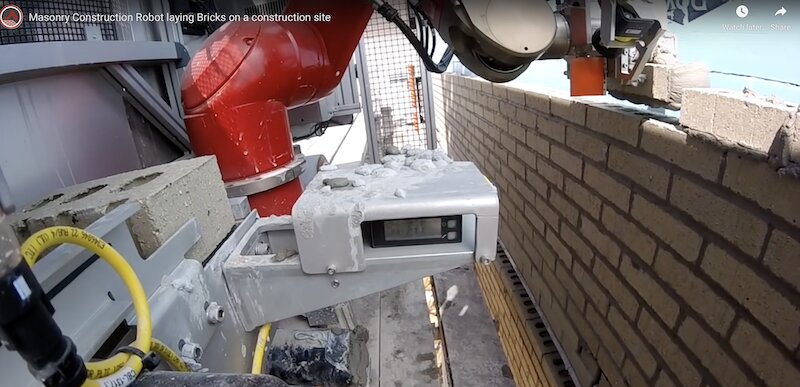A 166,000-sf barracks with 300 bedrooms for 600 military personnel is under construction at the Great Lakes Naval Base in Illinois with the help of robots that can lay bricks every seven to 10 seconds and can lift and place foundation blocks weighing up to 135 lbs.
This $52 million project, started last March and scheduled for completion in October 2020, represents the debut of semi-robotic construction for the general contractor Clark Construction Group. Construction Robotics, a Victor, N.Y.-based manufacturer that launched in 2007, is providing the machines, which are called MULE (for Material Unit Lift Enhancer) and SAM (for Semiautomated Mason). Blinderman Constuction is Clark's partner on this project.
This is also the first construction project in the country to use MULE and SAM technology in tandem.
There are currently more than 130 MULEs operating in the field, and 11 SAMs, with more under production, says Scott Peters, president and cofounder of Construction Robotics. His company has worked with more than 80 contractors, from large GCs like Barton Malow and Wilhelm Construction, to local masonry subcontractors like Leidal & Hart Mason Contractors in Michigan and Jimmy ‘Z Masonry in Crystal Lake, Ill., the latter of which is working on the abovementioned barracks project, and reportedly advocated for the use of robots.

The SAM robot can lay brick at a pace of one every 7-10 seconds.
Construction Robotics’ machines have installed more than one million sf of wall, says Peters, whose training is in engineering. His partner, Nate Podkaminer, has a background in architecture and construction.
Tyler Shawcross, Clark’s senior project manager, says that his company first met with Construction Robotics’ principals about five years ago. “Our R&D team is always looking for ways to build smarter,” he says.
When asked how this technology benefits masons at a time when workers are losing their jobs to automation in many industries, Shawcross notes that masonry, like many other construction trades, is suffering from labor shortages and an aging workforce. Plus, he adds, these trades simply are not attracting younger workers.
Construction Robotics has had a training program for masons in place since 2018. Both Peters and Shawcross agree that the technology not only has the potential for extending the work longevity of masons, but also might entice younger workers to consider entering the profession.
MULEs cost between $70,000 to $80,000 to purchase and are relatively simple to operate. For the barracks project, the MULE grabs the 32-inch blocks (which Oldcastle developed specifically for this job). The mason positions the hoisted block onto the foundation row. “It’s like an extension of your hand,” says Shawcross.
SAMs are more complicated machines that require three-to-five days of training to operate. The machines are generally leased by the week, month, or longer. Peters is reluctant to discuss pricing because, he explains, each project is different and requires customized software coding. (Peters notes that SAMs can be programmed to lay bricks in complex patterns and color sequences.)
To view videos of MULE and SAM in action, click here.
Construction Robotics claims SAMs reduce labor costs by at least 30%. Shawcross couldn’t quantify the time and cost savings from using the robots. He notes, though, that the machines provide a reliable production rate. “We see it as an opportunity to drive cost certainty into a project. I don’t think it’s a large cost reducer, but it could be a scheduling reducer.”
Peters says that robotics are most effective in construction when they are factored into the building process early in the planning stage. “That’s why we engage with GCs like Clark.” He concedes, however, that the construction industry in general is slow to change. “Companies need to think about new technology, and use their money to learn.”
Shawcross believes that robotics will become more prevalent on jobsites for performing repetitive tasks. Peters says that on another project, a MULE was used to move concrete form panels into place. “It’s one of those rare products that provides both speed and safety,” he says.
Related Stories
AEC Tech | Oct 16, 2024
How AI can augment the design visualization process
Blog author Tim Beecken, AIA, uses the design of an airport as a case-study for AI’s potential in design visualizations.
3D Printing | Oct 9, 2024
3D-printed construction milestones take shape in Tennessee and Texas
Two notable 3D-printed projects mark milestones in the new construction technique of “printing” structures with specialized concrete. In Athens, Tennessee, Walmart hired Alquist 3D to build a 20-foot-high store expansion, one of the largest freestanding 3D-printed commercial concrete structures in the U.S. In Marfa, Texas, the world’s first 3D-printed hotel is under construction at an existing hotel and campground site.
AEC Tech Innovation | Oct 8, 2024
New ABC technology report examines how AI can enhance efficiency, innovation
The latest annual technology report from Associated Builders and Contractors delves into how artificial intelligence can enhance efficiency and innovation in the construction sector. The report includes a resource guide, a case study, insight papers, and an essay concerning applied uses for AI planning, development, and execution.
AEC Tech | Oct 4, 2024
Publication explores how facility managers can use AI
A new guide, “Gamechanger: A Facility Manager’s Guide to Building a Relationship with AI,” provides a roadmap to understanding and using AI in the built environment.
AEC Tech | Oct 3, 2024
4 ways AI impacts building design beyond dramatic imagery
Kristen Forward, Design Technology Futures Leader, NBBJ, shows four ways the firm is using AI to generate value for its clients.
AEC Tech | Sep 25, 2024
Construction industry report shows increased use of robotics on jobsites
Nearly two-thirds of contractors surveyed, who cited use of robotics on jobsites, are either using monitoring and/or service/labor robotics.
AEC Tech | Sep 24, 2024
Generative AI can bolster innovation in construction industry
Jeff Danley, Associate Technology and Innovation Consultant at Burns & McDonnell, suggests several solutions generative AI could have within the construction industry.
3D Printing | Sep 17, 2024
Alquist 3D and Walmart complete one of the nation’s largest free-standing, 3D-printed commercial structures
Walmart has completed one of the largest free-standing, 3D-printed commercial structures in the US. Alquist 3D printed the almost 8,000-sf, 20-foot-high addition to a Walmart store in Athens, Tenn. The expansion, which will be used for online pickup and delivery, is the first time Walmart has applied 3D printing technology at this scale.
3D Printing | Sep 13, 2024
Swiss researchers develop robotic additive manufacturing method that uses earth-based materials—and not cement
Researchers at ETH Zurich, a university in Switzerland, have developed a new robotic additive manufacturing method to help make the construction industry more sustainable. Unlike concrete 3D printing, the process does not require cement.
AEC Tech | Aug 25, 2024
Are AI opportunities overwhelming design and construction firms?
A new survey of A/E firms found that more than three-fifths of 652 respondents expect AI to improve their operational efficiency. That survey, though, also found that the same portion of respondents wasn’t using AI yet, and two-thirds admitted they were struggling with where and how to apply AI.

















